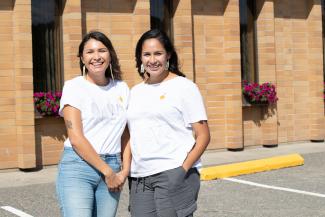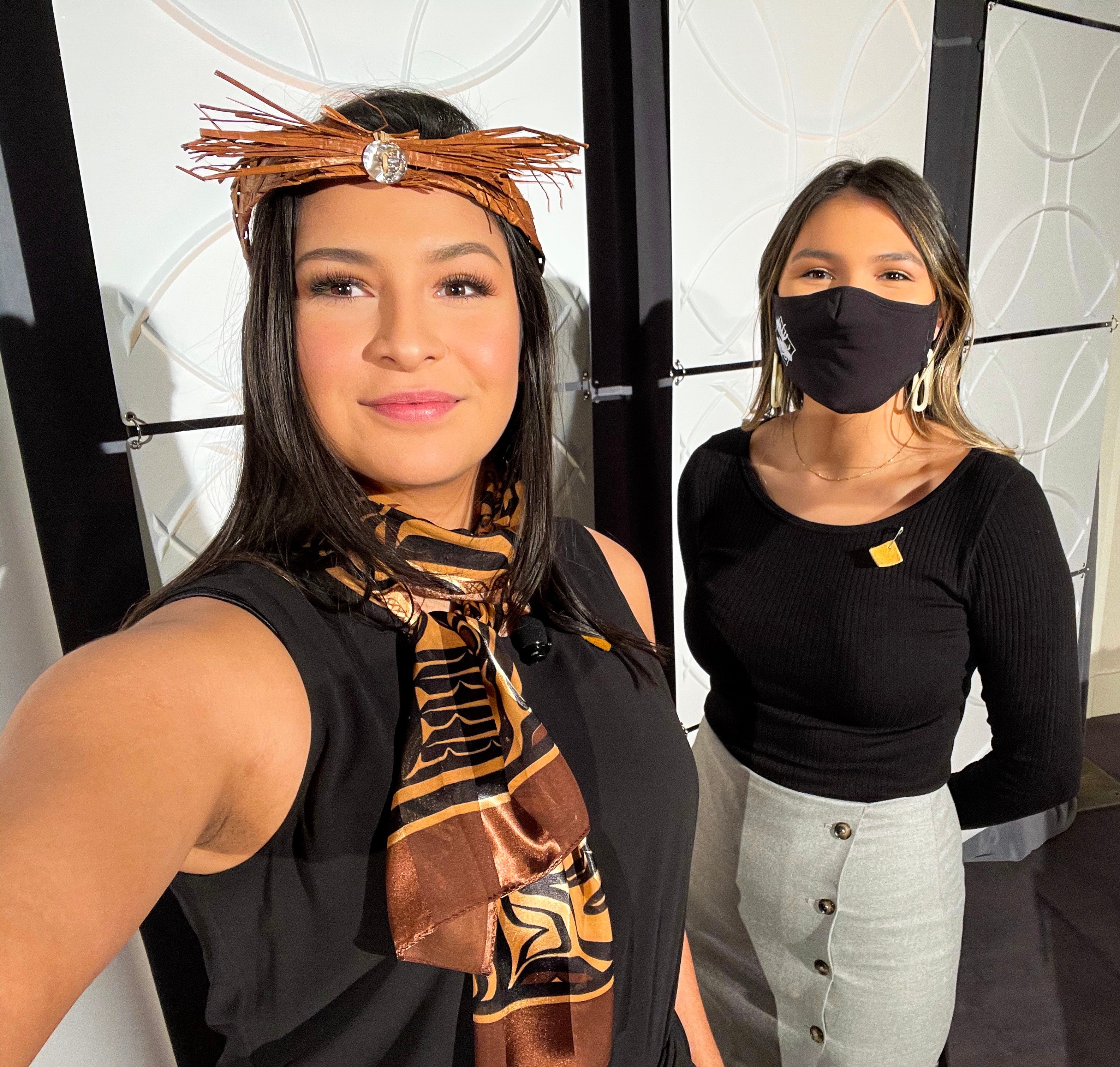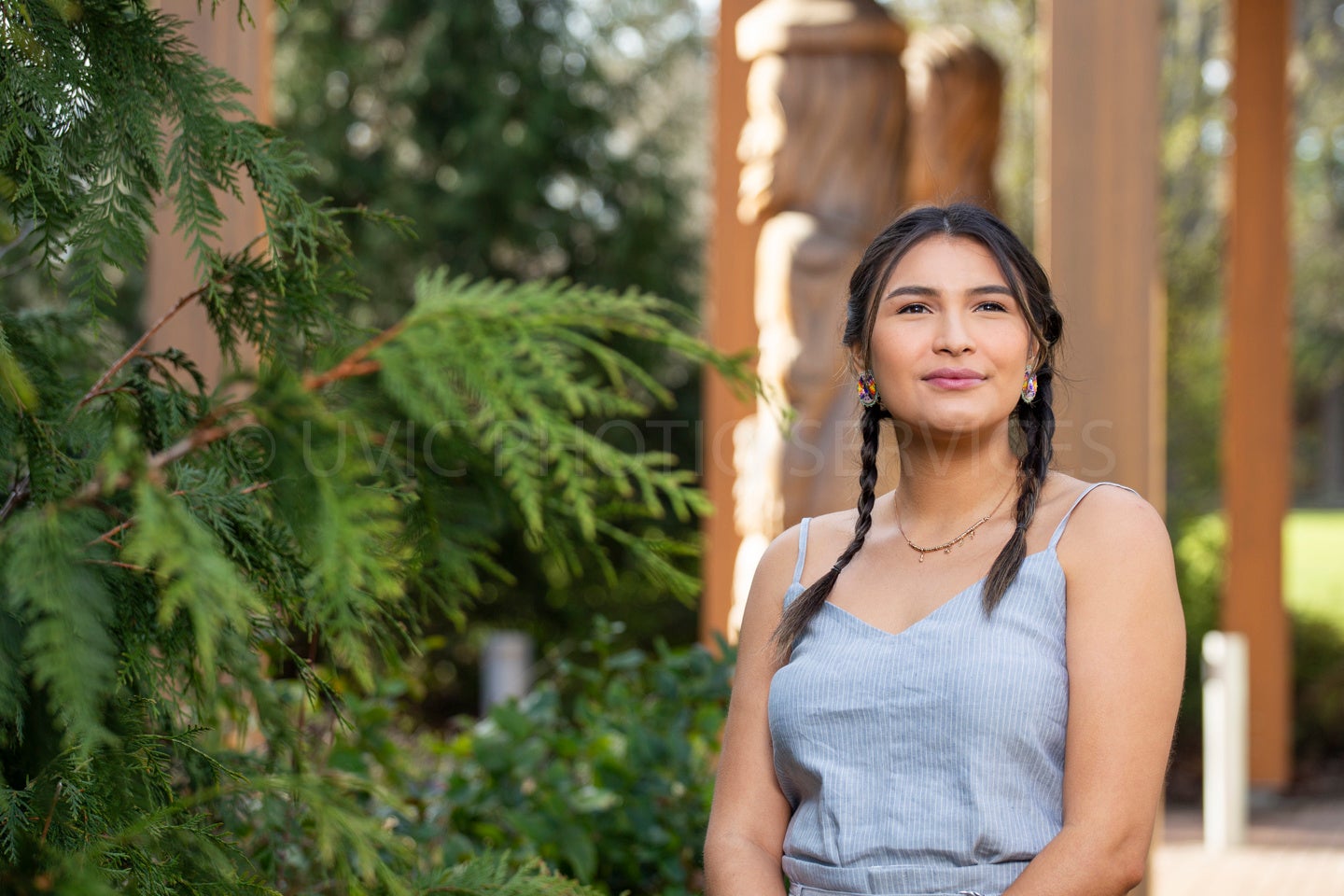
Hadih, Raven Lacerte and Sage Lacerte Sahdnee. We are Raven Lacerte and Sage Lacerte. Loretta Madam S’loo. Our mom is the late Loretta Madam. Paul Lacerte S’ba. Our dad is Paul Lacerte. Sigh Gunna Lushiboo Injun Yinkak Dene Keyoh. We are Carrier Peoples, members of the Lake Babine Nation and we belong to the Bear Clan. Te Be Snachalya injun Lekwungen keyoh. We acknowledge the territory of the Lək̓ wəŋən-speaking Peoples, the Songhees and Esquimalt First Nations in what is now Canada.
Two sisters, two movements, two aligning stories that have the shared ultimate impact goal of empowerment and rematriation. This is a story of two young Indigenous leaders working to make life better for our people.

My name is Raven. I am the mother of Cedar Sus (Sus means bear in Carrier) and I am the proud partner of Dominic Paul. I am the co-founder of the Moose Hide Campaign, which is working to end violence towards women and children. My dad, Paul Lacerte, and I started this movement when I was just 16 years old. Being a visibly Indigenous person, I know something bad can happen to me, my sisters, or any of the women or children in my life. There have been over 4,000 Indigenous murdered or missing women and girls in the last 30 years in Canada. Indigenous women are disproportionately affected by violence. I wanted to do something that was centered in love and healing. Now that I am a mother of my own daughter, I feel even more compelled to spend my time working to make this country safe for my daughter so that she can live a life free from fear, free from violence, with nothing but opportunity in her path.
The Moose Hide Campaign is a grassroots effort to end violence towards women and children, and was founded in 2011 on a moose hunting trip on the traditional Carrier territory along Highway 16, also known as the “Highway of Tears.” Our work invites men and boys to mobilize in their efforts towards ending violence. After working in this field for so many years, we needed to stop and question, “Where are all the men?” We invite men, and all Canadians, to practice reflection, make a commitment to ending violence in their own lives, and to help spread awareness to make real change. We envision a country where all women and children are free from violence.
There are two main features of the Moose Hide Campaign. We offer one-inch squares of moose hide for folks to wear every day as a signal of safety and mutual accountability. We also invite men, women, trans, Two-Spirit, and LGBTQIA+ folks to Moose Hide Campaign Day, an annual one-day fasting ceremony where we come together and practice vulnerability by sharing openly about our lived experiences and our commitment to healing. To date, we have distributed more than two million squares of moose hide, and mobilized more than 80,000 Canadians at this year’s National Gathering. Our goal is to have a one million-person fast and to give out 10 million moose hide squares. You can order free moose hide pins on our website. An essential element for promoting gender and racial equality is to employ Indigenous innovations that benefit all Canadians in an effort to stand together in ceremony while we work towards these goals.

My name is Sage Lacerte. I am the founder and CEO of Sage Initiative and the proud National Youth Ambassador of the Moose Hide Campaign. I am a self-described Indigenous feminist queer musician-warrior-learner. In 2020, I concluded the first segment of my learning odyssey at the University of Victoria to better understand how power functions across humanity and the histories of Indigenous nations around the world.
I was introduced to narratives about money and wealth at a very young age. I remember having anxiety in the grocery store about having to count every dollar to make sure we could get all the essentials. We would go for long walks all the way downtown, stopping at playgrounds on the way for a quick push on the swing before getting groceries. Mum would talk to the other adults while Raven and I colored at the toy table and I “patiently” waited for my bi-weekly special sugary lunch treats. Our mother is an example of the resilience required in Indigenous motherhood. Her rift relationship with the colonial Canadian state after having attended residential school never presented itself as resentment; rather, she chose a pathway in which her four daughters were driven by joy, curiosity, and most of all, a brilliant, unfettered opportunity to find fulfillment in everything we do.
That’s why I founded the Sage Initiative, the first and only Indigenous womxn’s impact investment collective across Turtle Island. It is our vision to enable a national ecosystem of Indigenous womxn impact investors who make capital available to Indigenous-owned Funds and social enterprises. This innovation has been a long-awaited solution to Indigenous business owners’ biggest barrier: the lack of access to capital, in conjunction with unbalanced gender representation in all major fields including finance, STEM, and medicine. This is where I stopped to ask, “where are all the womxn”?
The Sage Initiative supports Indigenous womxn (trans, Two-Spirit, LGBTQIA+) in Canada to invest between $1,000–$50,000 after completing our investment curriculum to strengthen their investment-related skills and capacity by interweaving these competencies with Indigenous concepts of commerce and wealth. This trauma-informed approach addresses colonial relationships with money and overlapping identities such as Indigeneity, age, and sexuality, using a gendered perspective.
We are the first generation of our family with the resources to create a pathway to prosperity by investing good medicine into our communities. By re-storying money as medicine, our hope is to be a role model for the investment industry and to encourage younger Indigenous womxn to join this movement and rematriate Indigenous economies together by resurfacing the economic balance that exists in our matriarchal societies. As an Indigenous innovation in social finance and impact investment, we are creating a new industry that is anchored in community, reciprocity, and love for oneself, our human and non-human relatives, and Mother Earth. The concept of #Indigenomics taught me that we are currently witnessing an emerging Indigenous economy; these innovations are our collective response to the lasting legacy of the systemic exclusion of Indigenous Peoples from the economic table of this country. Those who have been accumulating capital and occupying space where our matriarchs once sat, gird your loins and prepare for your opportunity to learn more about and participate in economic reconciliation.
Our barriers, challenges, and struggles have helped lead to where we are today. Each morning a decision is made to break cycles of what we don’t want and create more opportunities for more of what we do want, need, and desire. It has become our family philosophy to consider all of our relations and experiences to be precious. These are the ingredients that make up our tool basket.
Our dad became a young leader in his 20s, just like us. He became the executive director of the British Columbia Association of Aboriginal Friendship Centres and began to teach us how to use our voice in a good way, and to always introduce ourselves in circles and at his work meetings. Each of us grew up as Friendship Centre babies where we were intentionally mentored from a young age—“the sweetest Carrier girls I ever saw!” our aunties would say.
Intentional mentorship doesn’t just happen. We were chosen for this work. Everything that our ancestors, parents, and grandparents have gone through and sacrificed has been for us. These sacrifices were made for the young ones and future generations to enjoy the full protection and guarantees against all forms of violence and discrimination, and more importantly, to continue to speak our language, to practice our culture and ceremonies, to understand our rules of governance, and to be in service of our relatives.
In Western institutions, young people are armed with knowledge that benefits settler colonialism, heteropatriarchy, and capitalism. These systems were not built on Indigenous values or epistemologies; therefore, they were not built for us. Because of this, we decided we had to form our own institutions of learning: in the words of Audre Lorde, “the master’s tools will never dismantle the master’s house.” We are choosing to work from our own worldview. We brought our own tools. Our tool baskets are filled with good medicine, and we are bringing them into the “master’s” house.
We are weaving together our vision of empowering Indigenous womxn and children to achieve self-determination. Self-determination and gendered violence are among the most important and pressing issues for Indigenous womxn worldwide, and there is an intimate relationship between harm reduction and economic empowerment. Moose Hide Campaign and Sage Initiative are sister movements that work to simultaneously advance the individual and collective rights of Indigenous womxn and explicitly address gender-based violence as an effect of colonialism.
This is an invitation to close your eyes and think about your mother. Now think about your mother’s mother. Now think all the way to our communal first mother, Mother Earth. Each one of you reading this, please know your ancestors are always with you and they love you! As our ancestors have led us to this point, each one of your ancestors has led you to the point you are at right now. Mussi Cho for reading about our story. We call on anyone who is willing to join us in our efforts to take a stand against violence in all its forms and to support rematriation.
Top photo: Sage and Raven Lacerte at their home town of Fraser Lake, BC, along the Highway of Tears (Hwy
16), near where the Moose Hide Campaign was founded. Photo by Jamil Mawani, Third Eye Productions.
